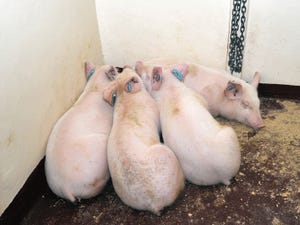Evaluating over feeding soybean meal in grow-finish pigs
Two studies were conducted to evaluate feeding high SBM inclusions on pig health and performance.
October 26, 2023

By Laura Greiner, Nicholas Gabler, Lance Baumgard, Jason Ross, Dalton Humphrey, Erika Johnson and Joseph Swanton, Iowa State University
Soybean meal is a primary ingredient used to provide amino acids in swine diets. Currently, synthetic amino acids are utilized widely in swine diets due to the cost of soybean meal and to reduce over feeding protein.
With expectations of an increased soybean crush in the Midwest and conversations surrounding the potential change in pricing due to the use of soybean oil in biodiesel, questions concerning the impact of increasing soybean meal in finishing diets have been raised. Subsequently, researchers at Iowa State University have been evaluating the potential of over feeding soybean meal beyond dietary amino acid minimum requirements. Two studies were conducted to evaluate feeding these high SBM inclusions on pig health and performance.
Across 240 pigs (20 pens per trt; 4 pigs/pen), grow-finish pigs were either fed one of three diets: 1) High in crystalline amino acids, 2) A diet with an inclusion level of SBM to replace crystalline lysine, or 3) A diet in which SBM replaced a level of corn (Table 1). All other aspects of the diets were unchanged and met or exceeded the requirements of the pigs. Pigs were fed these diets from ~24 kg body weight to market weight. Throughout the study, average daily gain, average daily feed intake, feed efficiency and nitrogen excretion were evaluated.
Iowa State University
The feeding of different levels of SBM did not alter growth and performance, with overall grow-finish ADG being 1 kg/d and feed efficiency was 0.43 (Table 2). Upon marketing of the pigs, the loin depth was not changed; however, the backfat depth was reduced from 1.26 to 1.09 cm as SBM level increased. As expected, nitrogen excretion was increased from 17.7 to 40.8 g/d as SBM inclusion increased in the diets in which the majority of the nitrogen was released through urine. Under these study conditions, barn air quality were adequate and no adverse pig health conditions were observed.
Iowa State University
At the end of phase 1, a subset of pigs (~50 kg BW) were placed into individual pens and environmental chambers to better understand if high SBM levels could impact the animal’s ability to adjust to heat stress. Compared to the thermoneutral controls, heat stress increased body temperatures and respiration rates. However, feeding of high SBM diets did not appear to change either parameter. Growth performance with this population of pigs, while reduced due to heat stress, was not impacted by increasing levels of SBM (Figures 1 and 2)
Iowa State University
Iowa State University
In summary, these data showed that that feeding high soybean meal above amino acid requirements will increase nitrogen emissions and may alter carcass composition. Further, these high crude protein diets do not appear to change performance during periods of high heat stress. Although barn air quality and pig health were fine, these needed to be monitored if one pushes excessive soybean meal (crude protein) inclusion rates in grow-finish pigs.
This project was made possible through funding by Iowa Pork Industry Center. The authors of this work are: L. Greiner, N. Gabler, L. Baumgard, J. Ross, D. Humphrey, E. Johnson and J. Swanstrom. The authors would like to acknowledge the assistance of Chloe Hagen, Sarah Elefson, Spenser Becker, Kayla Miller and Mitch Nisley for their assistance.
You May Also Like



